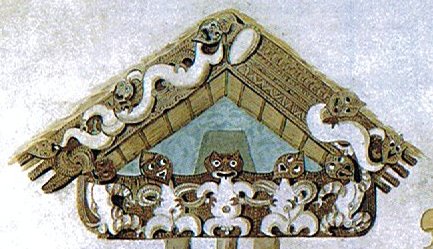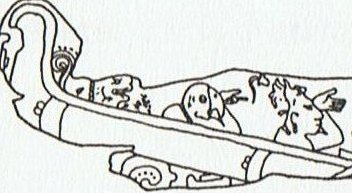The role of the clashing rocks have now been made rather clear: In order to let the poop remain on the surface without being submerged the clashing rocks have bitten the ship in two. Only the prow will now sink. Hatinga Te Kohe is the corresponding kuhane station - the 'bamboo staff' (kohe) is 'stepped on' by the kuhane and breaks:
In a separate set of pages I will try to give a translation better adapted to what we now know. On the surface remains the 'germ' of a new ship, or as it apparently is described at the apex of the Taranaki store house:
The terrified king (the 'Captain') is in the mouth of a beast, but his 'poop' ('doll') avoids the gap. His 'doll' remains inactive for a time, but then gives birth to twins. Man and woman paddling a canoe together will have the weaker one, woman, at the stern. I have been puzzled over why the rongorongo texts seem to say that sun is sinking down instead of rising towards high summer. Fists held high obviously indicate that all the 'fire' (fingers, rima) still remain intact. In a cold climate and barehanded you can keep your fingers warm by clenching them into a fist. Later an empty hand will show that no 'fire' is left. Maybe the empty hand of the 3rd passenger in the solar canoe is the same type of sign:
Is it the head of a turtle at the stern? Then comes a bird and then we are down on earth. The 'fire' in the sky (sun) is like other fires, they burn out. Yes. And in midwinter no 'fingers' of the new sun are yet used up. Fists are shown to prove it:
But why do they have to be held high? The sky in midwinter is low. Maybe the fists held high indicates the story is about the sky 'fire'. Another explanation, hard to evade, is that everybody knows gravitation brings things down. So the sun too must come down, and we can see it every day when he sinks in the west. So when sun sinks from a beginning high up in the sky and comes gradually closer to the earth it will become warmer. At midsummer it is really hot. Then sun must return up to his high position in the sky again. But how can that be accomplished? He cannot move against the force of gravitation. The answer is obvious. He has continued to sink beyond midsummer and he has gone down into the depths of he sea. He moves very deep. But at the lowest of lowest he cannot go any further. His momentum has been used up. From such a deep, deep abyss, and with momentum now 'finished', the result is evident: he will start to rise again - his buoyancy will make him move faster and faster towards the surface of the sea. His spirit strives to move him upwards again, he is like a bird who has dived for fish. And when he breaks the surface he will have gained so much momentum that he will continue up into the sky to where he once started. This, in short, is - I guess - what once was the explanation for the movement of the sun over the year. Gravitation moves him down, buoyancy moves him up. The prow is the male part of the ship and the poop the female part. The prow goes down, but the poop sails on. Moon is always potentially visible, but Sun cannot be seen during the night. He has only 'one leg'. The Ship (and by the law of correspondence also every other ship) must be female. A Cherokee myth retold in The Whirlpool in a way supports my interpretation, but also will enable us to extend the model to include Mount Meru and to recognize this important 'mountain' among the glyphs in the rongorongo texts. |
|||||||||||||||||||||||||||||||||||||||









